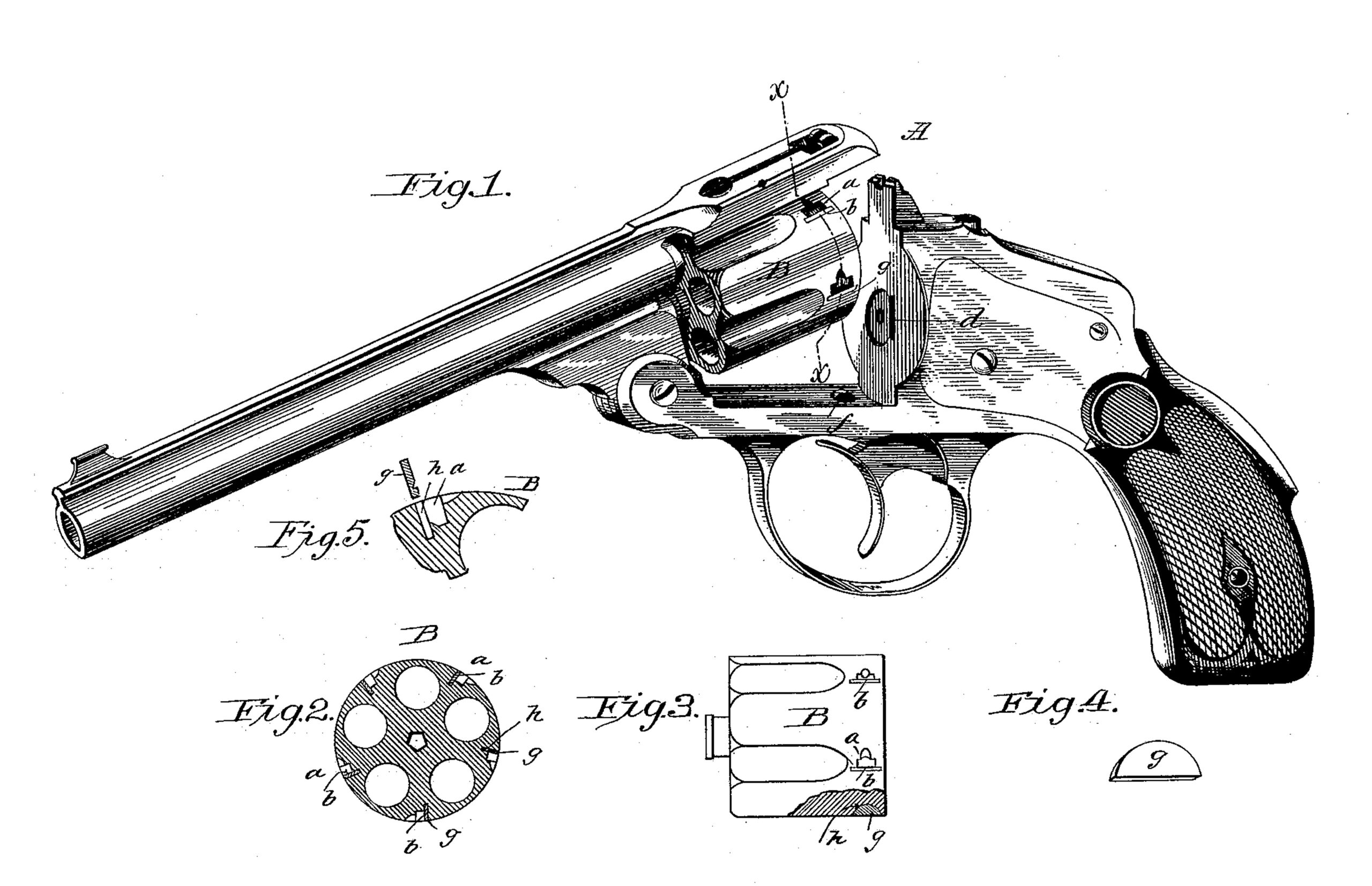US 401087
UNITED STATES PATENT OFFICE.
DANIEL B. WESSON, OF SPRINGFIELD, MASSACHUSETTS.
REVOLVING FIREARM.
SPECIFICATION forming part of Letters Patent No. 401,087, dated April 9, 1889.
Application filed January 31, 1889, Serial No. 298,277. (No model.)
To all whom it may concern:
Be it known that I, DANIEL B. WESSON, a citizen of the United States, residing at Springfield, in the county of Hampden and State of Massachusetts, have invented new and useful Improvements in Revolving Fire-Arms, of which the following is a specification.
This invention relates to an improvement in revolving fire-arms, and particularly to the notches in the sides of the cylinders thereof, the purpose thereof being to render the walls of said notches more enduring, resulting in the increased efficiency of the cylinder; and the invention consists in the improved cylinder having the abutment-wall of each catch notch thereof formed of a block of suitable material harder than that from which the cylinder proper is formed and let into a recess thereof and there rigidly secured, substantially as will hereinafter more fully appear.
In the accompanying drawings, forming part of this specification, this invention is illustrated, Figure 1 being a perspective view of a revolver as in a partially-opened position, showing the abutment-walls of its cylinder as formed with an indurated block. Fig. 2 is a cross-sectional view of the cylinder on the line x x, Fig. 1. Fig. 3 is a side elevation of the cylinder, a part thereof being broken away and in section, the plane of section being taken through one of the blocks forming the abutment-wall for one catch notch thereof; and Fig. 4 is an enlarged perspective view of one of the indurated blocks detached. Fig. 5 is a sectional view in detail, to be hereinafter referred to.
In the drawings, A represents a revolver of common and well-known construction, in the cylinder B of which is a catch-notch, a, for each of the chambers in said cylinder, of each of which notches b is the abutment-wall, and said notches are adapted, when the cylinder is rotated in the usual manner by a pawl playing in a slot, (seen at d, Fig. 1.) to be brought to a quite sudden and forcible bearing against the cylinder-catch f in the bottom of the stock-frame, said cylinder catch having a vertical movement in a socket therefor in said frame to release the cylinder to move and then to limit its movement to but an extent corresponding to the distance between two of the cylinder-chambers.
From the speed and force with which the cylinder is rotated, and from the fact that at the time the plane of its notch abutment wall reaches the abutting face of the said cylinder-catch said catch may have only partially reached its normal outermost position, whereby but a small outer area of the abutment-wall receives the impact of and by the said catch, the said abutment-walls have heretofore, under a continued use of the fire-arm, become battered or indented and worn away, and more or less imperfectly serving in operation to maintain the cylinder in proper adjustment as to cylinder-chamber and barrel alignment. To this end the abutment wall of each catch-notch is comprised in and formed by the one side of a block of material harder than that from which the cylinder itself is made, forced into or secured in a recess in the cylinder-body at the end of the said notch.
In practice the said cylinder of the arm is made of soft or untempered steel, and after the stop-notches have been cut therein in the usual way the recesses in the cylinder which are to receive said abutment-blocks are cut by a mill or other suitable tool, and said blocks g, having been made to fit very tightly in said slots, are then forced into and thereby rigidly secured in the latter in the positions shown in Fig. 2; or the catch-block in the cylinder and the block may be formed as shown in Fig. 5, the corner of the catch-notch next to the recess for receiving the said block being formed full and the block next to said full corner having a niche therein, and the stock forming said full corner of the catch notch is by a suitable punch forced into said niche.
What I claim as my invention is–
1. A cylinder for revolving fire-arms, provided with peripheral catch-notches having the abutment-wall of each thereof formed of a block of suitable material harder than that from which the cylinder proper is formed and let into a recess therein and there rigidly secured, substantially as and for the purpose described.
2. In a revolving fire-arm, the combination, with the stock or frame provided with a cylinder-catch, of the cylinder provided with peripheral catch-notches having the abutment-wall of each thereof formed of a block of suitable material harder than that from which the cylinder proper is formed and let into a recess therein and there rigidly secured, substantially as and for the purpose described.
DANIEL B. WESSON.
Witnesses:
WM. S. BELLOWS,
G. M. CHAMBERLAIN.

